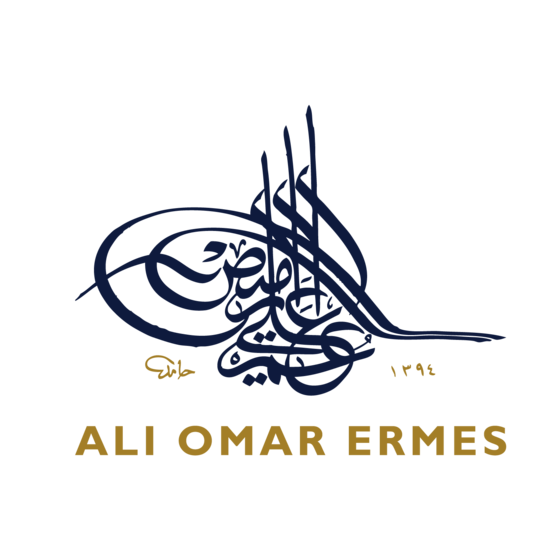Art as a Bridge
The artwork featured in this article is (on the left-hand side) by Ali Omar Ermes titled ‘Scattered Letters‘ (1969) and is with a private collector and ‘Adhadh in Nasakh Mohawar’ (1991) which is held in a private collection (bottom left).
Dr James W Allan is the Keeper of Eastern Art, Ashmolean Museum, Oxford
It is a great pleasure for me to introduce the paintings of Ali Omar Ermes. In 1992 I had the privilege of exhibiting his work in the Ashmolean Museum in Oxford, and that experience of both the man and his paintings gave me a new appreciation of the richness and diversity of personality, and of the extraordinary creative ability, with which God has endowed mankind. And yet there are cultural and religious differences which have to be faced if I, as a western Christian, and others like me, are to benefit fully from the paintings of an Arab, Muslim artist.
Relations between Christianity and Islam have not always been happy. A nation-state claiming to represent either of these religions will use its power be it economic, military or moral to oppress people of the other faith, to limit their freedom of choice or action, sometimes using force to persuade. There are intolerance and guilt on both sides, and the twentieth century is no less stained with these attitudes than the centuries that went before, as the wounds and hurts of Bosnia and Sudan so sadly illustrate. Both religions claim to hold universal truth so that in one sense disagreement is inevitable. The real problem for human relations, however, comes not from such contrasting views, but from the conflicts started by the fanatical among their adherents and those who can see profit in manipulating the truth to their advantage. Often fear is the motive. Those who know the truth need have no fear of others. All too many of us, however, are insecure: we are frightened by the idea that others can find a truth which convinces, but one which, at the same time, we do not share.
How can we bridge this divide? How can people of different persuasions be drawn together? Man tends to impose one of two solutions: he chooses either forcible partitioning, the placing of people in groups according to ethnic, linguistic or religious identity, or the forcible imposition of a single solution on all.
But there are other ways, creative ways, ways of peace. One such way is undoubtedly through art. This is not something new. In medieval times it was a regular feature of life in the Islamic world. The same craftsmen, whether they were Muslim or Christian, worked for patrons of both faiths. In 13th century Egypt, for example, craftsmen making ivory-inlaid furniture might make a screen for a Coptic church one month, and a minbar for a Muslim mosque another. We have no idea whether such craftsmen were Muslim or Christian, nor does it matter: they used a common vocabulary of arabesques and geometrical designs acceptable to, and accepted by, members of both faiths. If their patron chose to distinguish his faith, then for the one they would add crosses, for the other Quranic quotations. For a short period in the first half of the 13th century, Muslim patrons even found elements of Christian iconography acceptable on objects manufactured for court use. Such objets d’art, therefore, played a very important role in helping to bridge the gap between adherents of the two faiths. In our time we desperately need such bridges and, if we will allow it, Ali Omar Ermes‘ paintings provide us with them. He works in a country whose traditions go deep into its Christian past, even if they have been increasingly taken over and reinterpreted by the secularists of the present century. From this western tradition, he unashamedly draws his technique, the use of acrylic, ink, and paper, together with the scale of his compositions, and indeed the concept of painting as opposed to calligraphy or book illustration. What his paintings portray, on the other hand, comes from his own Arab and Muslim background: Arabic letters and early Arabic poetry. The letterforms take us back into the world of Arabic calligraphy, an art form hallowed by the use of Arabic for the Muslim holy book, the Quran, while the poetry introduces us to the literary culture of the Arab people, a literature of tremendous riches of which we are all too unaware in the western world. Not for nothing does one of his finest paintings focus on the Quranic word Iqra’, Read!.
The glory of Ermes’ art, however, like any art, is that appreciation does not depend on understanding every letter form or reading each Arabic word in one of his paintings. For these are only two small parts of the total composition. And it is that composition which does the true speaking; it has colour and rhythm, dimension and form, a sense of space, an atmosphere. These attributes are unique to each individual painting. They cannot be described. They can only be felt. As a result, we do not have to verbalise our feelings. We can simply enjoy them…
And the bridge is built.

